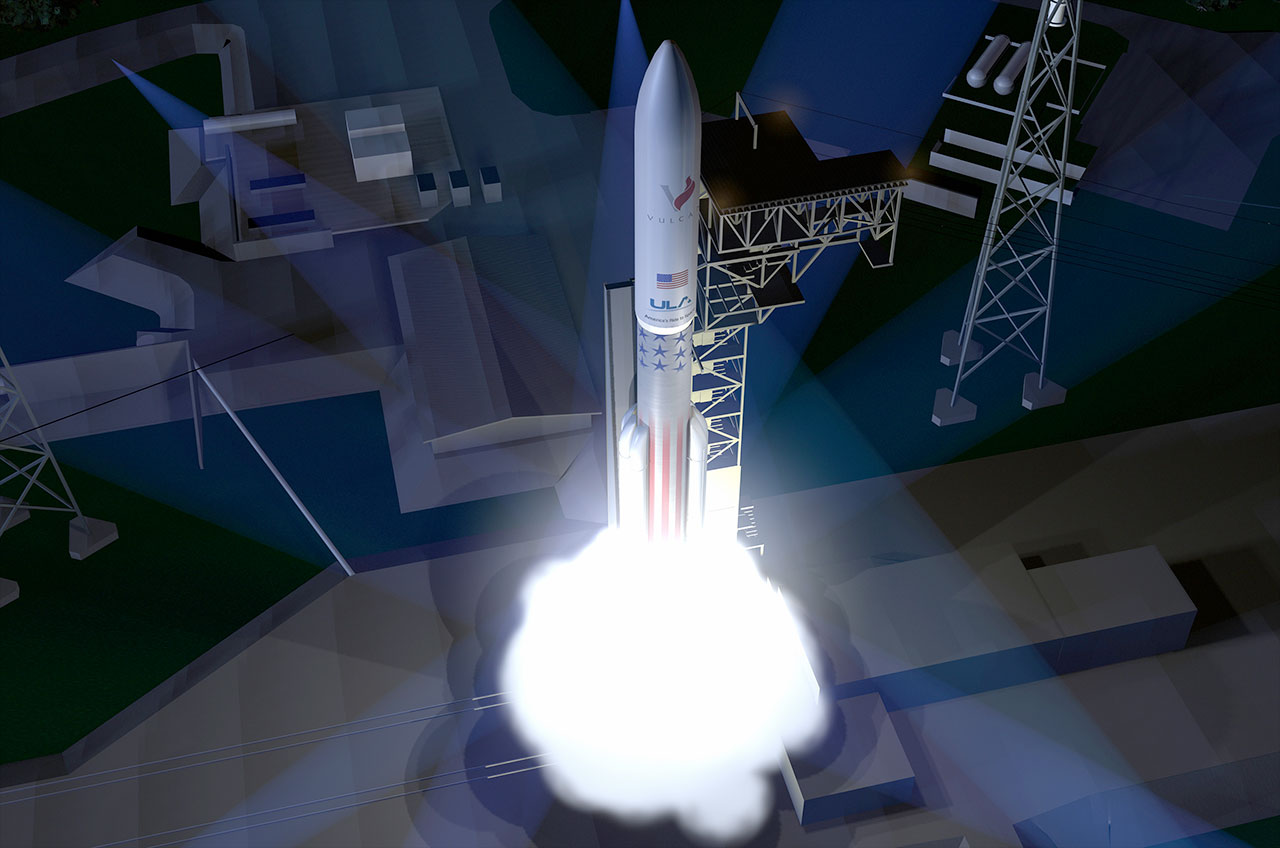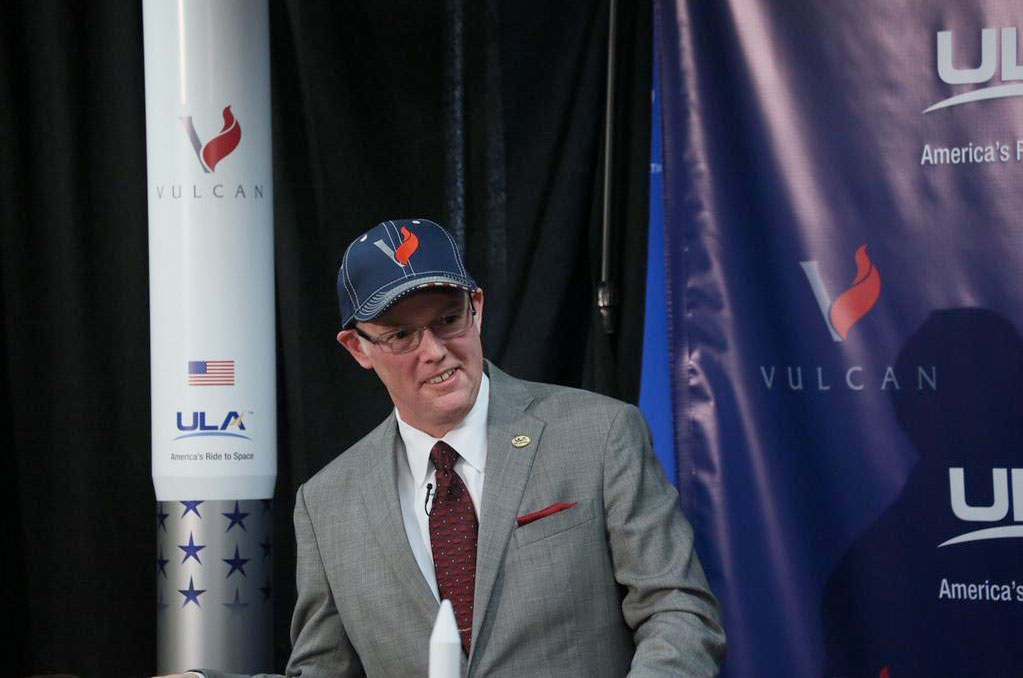'Behold Vulcan': Next-Generation Rocket Unveiled by United Launch Alliance
United Launch Alliance, the U.S. company behind the Atlas and Delta family of rockets, has unveiled Vulcan, its next generation launch system.
The new Vulcan rocket, which got its name through a poll that attracted more than a million votes, incorporates new engines, a reuse approach that features a mid-air recovery and a new upper stage aimed at enabling complex on-orbit operations.
"[Vulcan is] going to take the best parts of Delta and Atlas and combine them with new and advanced technology to provide a rocket that is not just as reliable and certain as Atlas has been, but also much more powerful, with higher performance, greater flexibility and [is] significantly more affordable," Tory Bruno, United Launch Alliance CEO, said in a press conference held Monday (April 13) at the Space Symposium in Colorado. [Video: ULA's 'Vulcan' Rocket, America's Next-Gen Launch Vehicle]
In March, the United Launch Alliance (ULA) announced that it plans to phase out use of all but the heavy-lift version of its Delta rocket by 2018. The Vulcan is ultimately intended to replace both the Delta and Atlas, initially as a medium-class launch vehicle to fly in 2019, and then in a heavy-lift configuration by 2024.
To accomplish this, ULA plans to follow a four-step plan, beginning with the Vulcan's new first stage.
Step 1, first stage
"The first step is this much more powerful booster," Bruno described. "It will sit atop a pair of advanced technology Blue Origin BE-4 rocket engines. They will burn clean and inherently reusable liquid oxygen and methane fuel."
Last year, ULA announced that it had partnered with Blue Origin, the privately-funded aerospace company owned by Amazon.com founder Jeff Bezos, to create a replacement for the RD-180 engines that power the Atlas today. Under pressure by Congress to phase out all use of the Russian-made RD-180s, ULA selected the BE-4 for the Vulcan.
Breaking space news, the latest updates on rocket launches, skywatching events and more!
"They will replace the venerable RD-180s, which generate 930,000 pounds of thrust. This pair of BE-4s will kick that up to well over 1.1 million pounds of thrust, a significant improvement in performance," Bruno said.
"They will sit underneath a stretched set of tanks that will contain significantly more propellant so that we can take advantage of the increased power to provide more impulse as we go to space," he added.
The new booster will also increase the number of possible side-mounted solid rocket motors by one more than Atlas, for a total of six, providing up to 20 percent more power.
At first, for the flights beginning in 2019, ULA plans to pair the new Vulcan first stage with its existing Centaur upper stage used with the Atlas. In the company's second step, the Centaur will be replaced by a more powerful Advanced Cryogenic Evolved Stage (ACES), offering the Vulcan with the ability to match the performance of the Delta IV Heavy rocket.
Step 2, second stage
"We are going to take a giant leap forward in our upper stage," Bruno said. "Burning liquid oxygen and hydrogen, it'll start with these very large high-capacity balloon tanks [that are] so thin, so lightweight, that on Earth they cannot even support their own mass. They would collapse without propellant or pressure to hold their shape. They are truly designed to fly in space."
The ACES will be powered by one to four rocket engines, which Bruno said will be chosen from the existing Aerojet Rocketdyne RL-10 that is used with the Centaur, the Blue Origin's BE-3, or a new engine based on technology being developed by XCOR Aerospace.
The ACES will also incorporate a new integrated vehicle fluids system.
"This is the ultimate in reuse," Bruno explained. "The thing that limits the performance of the upper stage systems in launch vehicles is time — time in space. Eventually our propellants boil off and we're out of usable propellant. This system changes all of that."
Using an advanced internal combustion engine developed by race car manufacturer Roush, the waste propellants will be recycled to re-pressurize the stage's tanks, to generate electrical power and to provide control and attitude thrust.
"This completely changes everything," stated Bruno. "This provides a tremendous extension to our ability to operate on orbit."
"We're going to go from hours to weeks with this system," he continued. "We can take multiple satellites into orbit, we can put them in different planes and when we are done with that we can fly back to space station for operations."
Steps 3 and 4: reuse and many uses
The third step of ULA's development plan is to introduce reusability. Instead of recovering the entire first stage, like its competitor SpaceX has been attempting to do using an ocean-based landing platform, ULA's "Sensible, Modular, Autonomous Return Technology," or SMART, initiative will seek to recover only the first stage engines.
"In this approach, when the booster is done and you are finished with the rocket engines, we will cut them off, we will return them to the Earth using an advanced inflatable hypersonic heat shield and then with a very low, simplified logistics footprint, we'll recover them in mid-air and return them to the factory to quickly recertify them and then plop them under the next booster to fly," Bruno described.
"This will take up to 90 percent of the propulsion cost out of the booster," he stated, adding that SMART is only the beginning of the company's plans for how to reuse other components of its launch system, with more details to be announced later. [The World's Tallest Rockets: How They Stack Up]
Finally, combining the three earlier steps, Bruno said the Vulcan rocket would be in position to offer distributed lift, enabling the launch of multiple spacecraft components on multiple launches that could then meet up in orbit by using the new ACES upper stage.
"Now this is the real game changer," he stated. "We could take on our first launch big fuel tanks, supplies, food [and] water, if it is manned mission. Then on the next flight, we bring up the spacecraft, the astronauts in their capsule, and with this advanced upper stage that can fly around for weeks, we can put these pieces together."
"We can go out and tap the resources that are in space," Bruno remarked. "We can asteroid mine and then build the infrastructure for a real and permanent human presence."
Of funds and fire
Bruno declined to specify what the four-step development of the Vulcan will cost, though he said it typically takes about a billion dollars to develop a new rocket engine and then another billion to place a rocket atop it. He said that ULA and its partners were funding the development effort.
As for the name, Bruno tossed aside hats bearing runner-up names like GalaxyOne and Zeus before donning a cap with a stylized "V." In Roman mythology, Vulcan was the god of fire. It is also the name of the fictional planet and alien species of Star Trek's Mr. Spock, played by the late Leonard Nimoy.
"It is Vulcan," Bruno said, revealing the name. "Behold the powerful Vulcan rocket."
Click through to collectSPACE to watch an animation of ULA's new Vulcan launch vehicle.
Follow collectSPACE.com on Facebook and on Twitter at @collectSPACE. Copyright 2015 collectSPACE.com. All rights reserved.

Robert Pearlman is a space historian, journalist and the founder and editor of collectSPACE.com, a daily news publication and community devoted to space history with a particular focus on how and where space exploration intersects with pop culture. Pearlman is also a contributing writer for Space.com and co-author of "Space Stations: The Art, Science, and Reality of Working in Space” published by Smithsonian Books in 2018.
In 2009, he was inducted into the U.S. Space Camp Hall of Fame in Huntsville, Alabama. In 2021, he was honored by the American Astronautical Society with the Ordway Award for Sustained Excellence in Spaceflight History. In 2023, the National Space Club Florida Committee recognized Pearlman with the Kolcum News and Communications Award for excellence in telling the space story along the Space Coast and throughout the world.



